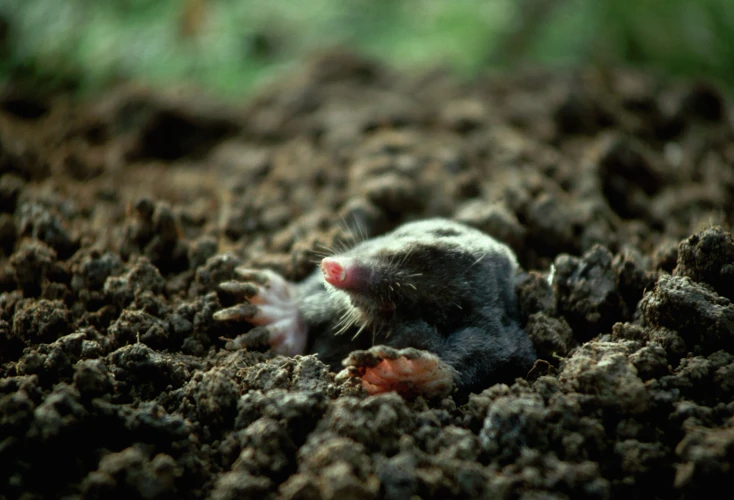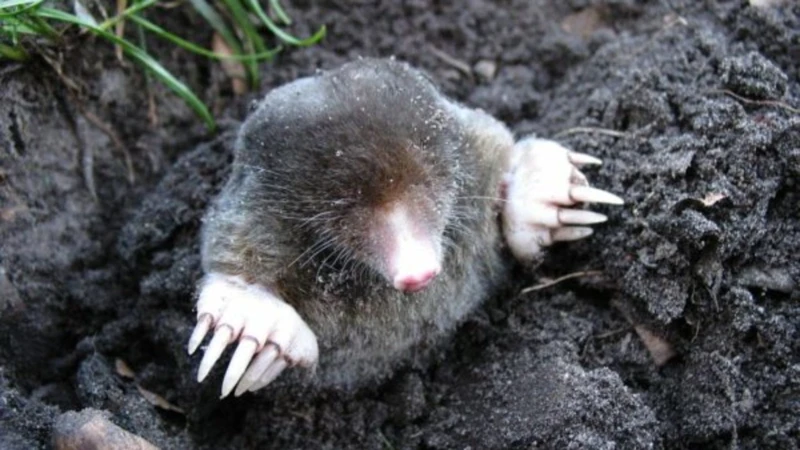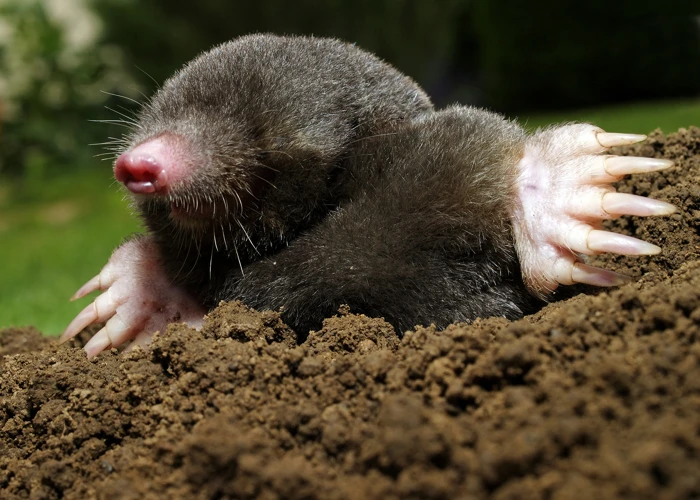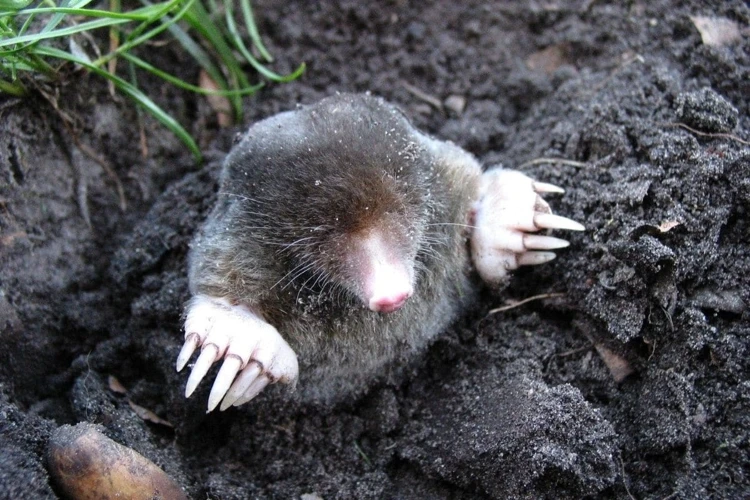If you’ve ever had to deal with mole infestations in your yard or garden, you may have wondered how they ended up there in the first place. The answer may lie in the connection between moisture and mole habitats. Moisture is critical to moles, and they tend to prefer environments with high levels of it. This article will explore why moles are attracted to moisture, how it causes them to move in, and how you can get rid of them by eliminating this crucial element. Additionally, we will provide tips on preventing mole infestations altogether.
Why Moisture is Critical to Moles

Moles are fascinating creatures that dig tunnels and create extensive underground habitats. However, what many people don’t realize is that moisture is critical to mole survival. Without adequate moisture, moles cannot thrive and survive. In this section, we’ll dive deeper into the reasons why moisture is crucial to moles, their moisture requirements, and the environments they prefer. We’ll also explore how moisture causes moles to move in and the signs of mole habitats in moist areas. For more information on mole habitats in yards, you can visit our article on mole habitats in yards.
Moisture Requirements for Moles
Moles have specific moisture requirements that they need to survive and thrive in their habitat. They are adapted to live in environments where the soil is damp and rich in organic matter, which provides a source of food and shelter. As soil dries out, it becomes harder and more compact, making it difficult for moles to excavate tunnels and find food.
According to research, moles are most active in soils with a moisture content of 20-30%. However, they can tolerate a wide range of soil moisture levels, from 14-90%. In general, moles prefer soil that is moist but not waterlogged, as they require oxygen to breathe.
To understand the importance of moisture to moles, it’s essential to consider their water intake. Moles do not drink water but obtain it from the food they eat, primarily earthworms. Earthworms contain a high percentage of water, which moles extract by squeezing the contents from the worms in their mouths. Moles need to consume a lot of food to meet their water requirements.
Moisture level in the soil also affects the abundance of earthworms, which are the main food source for moles. Earthworms are most abundant in moist soils, which provide them with the necessary moisture, nutrients, and oxygen for survival.
Table below summarizes the moisture requirements for moles:
| Soil Moisture Level | Effect on Moles |
|---|---|
| Below 14% | Soil becomes too dry for moles to excavate tunnels and find food |
| 14-20% | Moles can survive, but soil conditions are suboptimal |
| 20-30% | Optimal moisture level for moles, as soil is easy to excavate and contains a high number of earthworms |
| Above 30% | Soil becomes too wet for moles, and tunnels may collapse due to water saturation |
Understanding the moisture requirements for moles is crucial to prevent and remove them from the environment. By controlling the moisture level in the soil, we can make the environment unattractive to moles and deter them from settling in the area. To learn more about removing mole habitats, you can read an article on mole habitats removal.
Why Moles Prefer Moist Environments
Moles prefer moist environments for a number of reasons. Firstly, moisture helps them easily navigate through the soil. With moist soil, moles are able to move quickly and efficiently through it as they dig their tunnels. Secondly, moist soil is typically easier for moles to excavate compared to dry soil. The moisture helps to loosen the soil, making it easier for them to dig through it. This is particularly important for moles because they need to dig a large number of tunnels in order to create a habitat that provides them with enough food and shelter.
Additionally, moisture also helps to create a favorable environment for the earthworms and other insects that moles feed on. Earthworms, which are a staple of the mole diet, thrive in moist soil because it makes it easier for them to move through the soil and find food. This means that areas with higher moisture levels will also have a higher concentration of earthworms and insects, which in turn makes them more attractive to moles.
Moreover, moisture also plays a role in regulating the temperature and humidity levels within mole tunnels. In drier environments, the tunnels can become too warm and dry, which is not ideal for the moles. On the other hand, the moisture in the soil helps to keep the tunnels cool and humid, which provides a more comfortable environment for the moles to live in.
Understanding why moles prefer moist environments can help homeowners to identify the areas of their yard that are most attractive to these creatures. By identifying these areas, homeowners can take steps to eliminate the moisture and make their yard less attractive to moles. For more information on how to detect mole tunnels and create an unattractive environment for moles, check out our article on ‘/unattractive-to-moles-environment/’.
How Moisture Causes Moles to Move In

As homeowners, we pride ourselves on maintaining a beautiful lawn, but nothing is more frustrating than discovering a trail of fresh molehills that seem to appear out of nowhere. Contrary to popular belief, moles are not attracted to well-manicured lawns because of the soft soil, but rather because of the moisture content present in the soil. The moles are constantly seeking shelter and food sources, and moist soils provide the ideal environment for them to thrive. So, let’s explore how moisture causes moles to move in and the various ways they detect it. To learn more about other factors that contribute to mole habitats, check out soil type mole habitats, detecting mole tunnels, vegetation in mole habitats, or seasonal mole habitat behavior.
Hidden Moisture in Your Yard
When it comes to identifying sources of moisture in your yard, it can be easy to overlook certain areas. Here are some potential hidden sources of moisture that could be causing moles to move in:
- Leaking irrigation systems: Even a small leak in your irrigation system can create a moist environment that moles find attractive. Check your system regularly for any signs of leaks and repair them promptly if you find any.
- Clogged gutters: If your gutters are clogged, water may overflow and saturate the soil around your home’s foundation. This can create a moist environment that moles may be drawn to. Keep your gutters clean and make sure water is directed away from your home’s foundation.
- Low-lying areas: If you have low-lying areas in your yard where water tends to pool after a rainstorm, these areas can create the perfect environment for moles. Consider filling in these areas or improving drainage to prevent standing water.
- Over-watered plants: If you water your plants too frequently or for too long, you may be creating a moist environment that attracts moles. Be sure to only water your plants when necessary and avoid over-watering.
- Leaking outdoor faucets: Outdoor faucets that leak can create a moist environment in the surrounding area, which can attract moles. Be sure to fix any leaks as soon as you notice them.
By identifying and addressing these potential sources of moisture, you can reduce the likelihood of moles moving into your yard.
How Moles Find Moist Soil
Moles have very sensitive noses that help them locate moist soil. Here are some of the ways they find it:
- Smelling: Moles can detect soil moisture from a distance using their sense of smell. They use their long snouts to sniff out the earthy scent of damp soil, indicating potential food sources.
- Touching: Moles have highly sensitive front paws that they use to feel their way through soil. When they come across damp soil, they know that they have found a good place to dig for food.
- Following temperature changes: Moist soil typically has a different temperature than dry soil. Moles can sense this difference using their skin, which is highly sensitive to temperature. They can follow these temperature changes to locate areas of moisture.
- Observing other animals: Moles may also observe other animals that are drawn to moist areas, such as earthworms or insects.
By using a combination of these methods, moles can pinpoint the location of moist soil quickly and efficiently. This is why it’s important to address any moisture issues in your yard if you want to get rid of these pesky critters.
Signs of Moles Living in Moist Areas

Moles are elusive creatures that prefer to live in moist environments. If you suspect that moles have taken habitat on your property, there are some things you can look for to confirm the presence of these subterranean mammals.
Molehills: One of the most common signs of moles living in moist areas is the presence of molehills. These are raised mounds of soil that are pushed up by the mole as it digs tunnels underneath. The molehills will typically have a circular shape and will be about the size of a softball. If you notice molehills in your yard, it’s a good indication that moles have set up a habitat in the moist soil.
Raised ridges: Another sign of moles living in moist areas is the presence of raised ridges in the soil. These are caused by the mole as it tunnels through the earth, pushing up the soil above it. The ridges will be visible on the surface of the soil and may be several feet long. If you notice raised ridges in moist areas of your yard, it could be a sign that moles are present.
Plant damage: Moles can cause damage to plants as they tunnel underneath them. If you notice plants in your yard that are wilting or dying for no apparent reason, it could be a sign that moles are living in the moist soil around the roots.
Unusual behavior in pets: Pets can sometimes be a good indicator of the presence of moles. If you notice your dog or cat digging in the same area repeatedly, it could be a sign that there are moles living in the moist soil below.
If you notice any of these signs in areas of your yard that are moist, it could indicate the presence of moles. It’s important to take action to eliminate the moles and prevent further damage to your property.
How to Get Rid of Moles by Eliminating Moisture

If you’ve noticed mole activity in your yard, it’s essential to take action to eliminate them. One effective way to get rid of moles is by targeting the moisture in your yard, as they thrive in damp environments. In this section, we’ll discuss various ways you can eliminate moisture that attracts moles and prevent them from taking up residence in your yard. Let’s explore these methods below.
How to Find and Fix Leaks
One of the main reasons for excess moisture in your yard is often due to leaks. Leaks can be tricky to locate, but with some time and effort, you can find and fix them. Here are some steps to take to find and fix any leaks in your yard:
- Check your irrigation system: A common source of leaks is your lawn’s irrigation system. Check each sprinkler head to ensure it is not damaged or spraying in the wrong direction. Look for areas where the grass is excessively wet, as this may be a sign of a leak.
- Inspect your pipes: Another common source of leaks is damaged pipes running through your yard. Check for any visible leaks or damp areas in the soil surrounding the pipes. If you suspect a leak but can’t find it, you may need to hire a professional to use specialized equipment to locate the issue.
- Look for pooling water: If you notice water pooling in your yard, it may be a sign of an underground leak. Start by observing the area where you see the water and try to locate the source of the issue. Check for any damp or wet areas in the soil nearby.
- Fix any leaks: Once you have found the source of the leak, it’s time to fix it. Depending on the issue, you may be able to fix it yourself with some basic tools and materials. For more complex issues, you may need to hire a professional.
By taking the time to locate and fix any leaks in your yard, you can help reduce excess moisture and discourage moles from making your yard their home.
How to Lower Soil Moisture Levels
One effective method for eliminating moisture and discouraging moles from taking up residence in your yard is by lowering the level of moisture in the soil. Below are some ways to achieve this:
- Improve Drainage: The first step in lowering soil moisture is to review your yard’s drainage system. Make sure that any standing water or flooding problems are remedied. Poor drainage conditions lead to waterlogged soils that are ideal habitats for moles.
- Reduce Watering: Over-watering your lawn or garden can increase the water table in the soil, leading to an abundance of moisture that can attract moles. Reduce watering frequency, and when you do water, focus on delivering water deeply but less frequently.
- Improve Soil Structure: Improving soil structure can help to promote better drainage and reduce soil moisture. Soil amendments such as organic matter, perlite, or sand can help to create more porous soils that allow water to move through more quickly.
- Aerate the Soil: Aerating the soil can help to break up compacted soil, allowing water to move through it more quickly. This can be done manually or with aerating machines, which you can rent from garden centers.
- Use Mulch: Mulch is an excellent way to insulate the soil and reduce soil moisture levels. Applying a 2-4 inch layer of mulch around plants can help to reduce evaporation of soil moisture, keeping the soil dryer for longer.
By reducing soil moisture levels, you can make your yard less hospitable for moles, helping to discourage their activity in your lawn and garden.
Preventing Moisture-Loving Moles
As we have seen so far, moisture plays a critical role in the habitat selection of moles. These furry creatures thrive in moist environments, making it vital to eliminate any unnecessary sources of moisture in your lawn and garden. Now that we know how moisture causes moles to move in and the signs to look out for, we need to focus on prevention measures. In this section, we will explore some effective strategies to prevent moisture-loving moles from taking over your yard. By following these tips, you can keep your lawn and garden healthy and mole-free.
Lawn Maintenance Tips
Maintaining a well-manicured lawn is not only aesthetically pleasing, but it can also help prevent the intrusion of moisture-loving moles. Here are some lawn maintenance tips to keep your yard dry and mole-free:
- Mow frequently: Regular mowing keeps the grass short, which reduces the amount of moisture retained in the soil. Moles prefer taller grass as it holds more moisture and offers better protection.
- Aerate your lawn: Aerating your lawn allows water to penetrate deeper into the soil, which can help dry it out. Compacted soil can retain more moisture and attract moles.
- Water infrequently: Overwatering your lawn can create a damp environment that is perfect for moles. Water only when necessary, and try to water in the mornings to allow time for the soil to dry during the day.
- Control weeds: Weeds can hold excessive moisture in the soil, which can attract moles. Keep weeds in check with regular weeding and application of weed control products.
- Remove thatch: Thatch is a layer of dead grass and roots that accumulates on the soil surface. It can hold moisture and create a humid environment. Remove thatch regularly to keep your lawn dry.
- Fertilize moderately: While fertilizing can promote a healthy and lush lawn, excessive fertilization can result in excessive moisture retention in the soil.
By following these lawn maintenance tips, you can reduce the amount of moisture in your yard, making it less attractive to moisture-loving moles.
How to Keep Moles Out of Your Garden
To keep moles out of your garden, a combination of methods can be used to deter these critters from burrowing beneath your plants. Here are some effective ways to keep moles out of your garden:
| Method | Description |
|---|---|
| Barriers | Physical barriers such as buried fencing, mesh, or wire can help prevent moles from tunneling into your garden. Install the barrier at least 2 feet deep to ensure that moles cannot burrow beneath it. |
| Repellents | Moles are sensitive to certain smells and tastes, and repellents can be created using ingredients like castor oil, garlic, or hot peppers. However, keep in mind that these methods may need to be reapplied frequently. |
| Plant Selection | Choose plants that moles are less likely to tunnel beneath, such as those with woody stems or strong-smelling foliage. Alternatively, consider using raised beds or containers to grow plants above ground level. |
| Traps | If all else fails, traps can be used to capture moles. However, it’s important to use humane traps and to release the captured animals far away from your property. |
By using a combination of these methods, you can effectively keep moles out of your garden and protect your plants from damage.
Conclusion
In conclusion, it’s clear that moisture plays a critical role in the habitat of moles. They require moisture not only for survival but also as a key factor in deciding where to burrow and build their homes. Understanding the connection between moisture and mole habitats is essential for anyone trying to get rid of these rodents or prevent them from making their way onto their property.
Eliminating sources of moisture, such as leaks and damp soil, is an effective strategy for deterring moles from moving in. Regular lawn maintenance and limiting watering can also help keep them at bay.
However, it’s important to note that complete elimination of moisture from a yard is nearly impossible and may not be necessary. Moles will always find a way to adapt and survive, so it’s important to stay vigilant and take steps to prevent any buildup of moisture in areas where it can lead to their presence.
In the end, understanding the connection between moisture and mole habitats is essential for anyone dealing with these pests. By adopting proper prevention methods and early intervention when signs of moles are spotted, homeowners can enjoy a mole-free lawn and garden.
Frequently Asked Questions
How important is moisture for moles to thrive?
Moisture is critical for moles to survive as they require a constant source of water to maintain their metabolic functions.
What type of soil do moles prefer?
Moles prefer moist and loose soil, as it is easy for them to dig burrows and tunnel through the ground.
How do moles detect moisture in the soil?
Moles use their sense of smell to detect moisture in the soil. They typically migrate towards areas with higher soil moisture content.
Can a dry environment deter moles from inhabiting a particular area?
Yes, in general, dry areas are not conducive to mole habitats. However, moles can still thrive in areas where occasional rain or watering keep the soil moist.
What are some telltale signs of moles living in moist areas?
The presence of raised ridges or tunnels in the soil, along with small burrow openings, are evidence of mole activity in the area.
Do moles pose any harm to humans?
While moles are generally considered to be harmless creatures, their burrowing activities can damage lawns and gardens.
Are there any natural predators of moles?
Moles are preyed upon by various animals such as owls, hawks, snakes, and foxes.
How can you detect a moisture leak in your yard?
If there is an unexplained area of damp soil or standing water in your yard, this can indicate a moisture leak.
Can reducing moisture levels in your yard get rid of moles?
Yes, reducing the moisture levels in your yard can help deter moles from inhabiting the area as they prefer moist soil.
Are there any long-term solutions to prevent moles from inhabiting your yard?
Maintaining a well-draining lawn, keeping your yard free of debris, and planting less moisture-loving vegetation can help prevent moles from inhabiting your yard in the long term.







